The 1952 Alfa Romeo 1900, a symbol of Italian automotive excellence, emerged from a period of post-war reconstruction and burgeoning industrial growth. This iconic sports car, born from the innovative spirit of Alfa Romeo, became a defining model for the brand, showcasing its prowess in both design and engineering.
The 1900, with its sleek lines and powerful engine, captured the imagination of enthusiasts worldwide, becoming a cornerstone of Alfa Romeo’s enduring legacy.
The 1900, a testament to Alfa Romeo’s commitment to performance and elegance, was a groundbreaking vehicle for its time. It was not only a technological marvel but also a symbol of Italian design and engineering. This car’s influence extends beyond its initial impact, continuing to inspire automotive enthusiasts and designers to this day.
History and Background
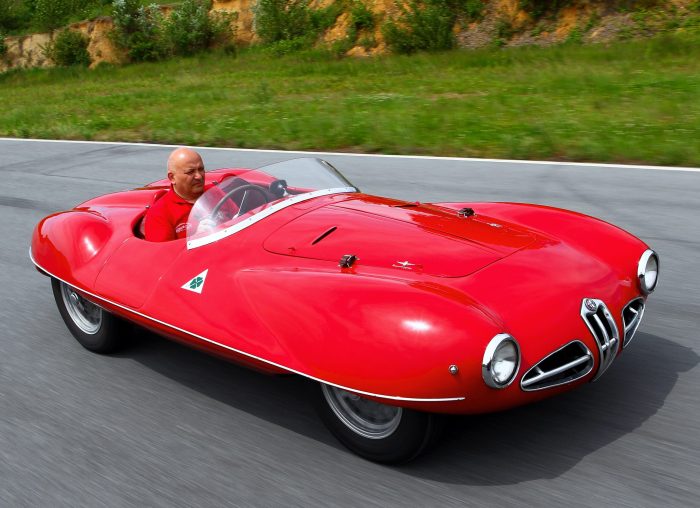
The Alfa Romeo 1900, launched in 1951, was a pivotal car for Alfa Romeo and a significant symbol of the Italian automotive industry’s post-war resurgence. This model marked a shift in Alfa Romeo’s strategy, moving away from pure racing cars and towards more accessible, yet still luxurious, road-going vehicles.
The 1952 Alfa Romeo 1900 was a groundbreaking car, showcasing the brand’s commitment to performance and elegance. Its legacy continued with the 1964 Alfa Romeo Giulia Spider , which built upon the 1900’s principles of sporty handling and stylish design.
The Giulia Spider further refined these elements, becoming a true icon of the Italian automotive industry, and solidifying Alfa Romeo’s position as a leader in sports car design.
The Italian Automotive Industry in the Post-War Era
The period following World War II saw a rapid revival of the Italian economy, and the automotive industry was no exception. This was a time of innovation and experimentation, as manufacturers sought to capture a growing demand for personal transportation.
Alfa Romeo, with its rich racing heritage, was well-positioned to capitalize on this trend.
Design Philosophy and Engineering Innovations
The 1900 was a testament to Alfa Romeo’s engineering prowess and its commitment to innovative design. The car’s design philosophy focused on a balance of performance, elegance, and practicality.
- Unitary Construction:The 1900 was one of the first cars to feature a unitary construction, a revolutionary approach at the time. This involved integrating the body and chassis into a single unit, resulting in a more rigid and lightweight structure.
- Double Overhead Camshaft Engine:The 1900’s engine, a 1.9-liter four-cylinder with double overhead camshafts, was a technological marvel. It delivered impressive power and performance for its time, showcasing Alfa Romeo’s engineering excellence.
- Independent Suspension:The 1900 incorporated independent suspension on all four wheels, providing superior handling and ride comfort. This feature was considered advanced for its era and contributed significantly to the car’s overall driving experience.
Design and Features
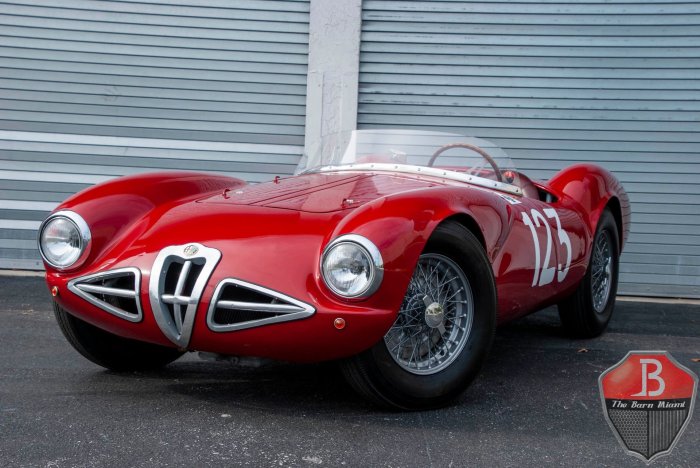
The 1952 Alfa Romeo 1900 was a revolutionary car for its time, blending elegant design with advanced engineering. It was one of the first production cars to feature a unitary construction body, which combined the chassis and body into a single, rigid unit, contributing to its superior handling and rigidity.
The 1952 Alfa Romeo 1900 was a groundbreaking car, known for its sleek design and powerful engine. Its legacy lived on in later models like the 1960 Alfa Romeo Giulietta Spider Veloce , which inherited the 1900’s sporty spirit and refined it with a more elegant aesthetic.
While the Giulietta Spider Veloce became a classic in its own right, the 1952 Alfa Romeo 1900 remains a testament to the brand’s enduring commitment to innovation and performance.
Exterior Design
The 1900’s exterior design was a departure from the traditional boxy shapes of the time. It featured a sleek, aerodynamic body with flowing lines and a distinctive grille. The car’s low, sloping hood, integrated fenders, and a gently curved roofline contributed to its elegant and sporty appearance.
The 1952 Alfa Romeo 1900 was a groundbreaking car, introducing a new era of performance and elegance for the Italian marque. Its legacy continued with the 1954 Alfa Romeo 1900 CSS, a special edition model that further enhanced the car’s sporting capabilities.
1954 Alfa Romeo 1900 CSS models are highly sought after by collectors today, highlighting the enduring appeal of the original 1952 design.
Interior Design
The 1900’s interior was designed with a focus on comfort and functionality. It featured a spacious cabin with comfortable seating for four passengers. The dashboard was well-organized and featured a range of instruments, including a speedometer, tachometer, and fuel gauge.
The car also came equipped with a leather-wrapped steering wheel and a wood-trimmed dashboard, adding to its luxurious feel.
Engine Specifications
The 1900 was powered by a 1.9-liter, four-cylinder engine, known for its smooth and powerful performance. The engine produced a respectable 90 horsepower, making the 1900 one of the fastest cars of its time.
The 1900’s engine was a technological marvel for its time, featuring a twin overhead camshaft design and a high compression ratio, contributing to its impressive power output.
The engine was mated to a four-speed manual transmission, providing a responsive and engaging driving experience.
Chassis, Suspension, and Braking Systems
The 1900’s chassis was designed to be lightweight and rigid, contributing to its handling and agility. The car featured an independent front suspension with coil springs and a rigid rear axle with leaf springs. The suspension system was tuned for a comfortable ride while maintaining excellent handling characteristics.The 1900 was equipped with hydraulic drum brakes on all four wheels, providing adequate stopping power for its time.
The 1952 Alfa Romeo 1900 was a groundbreaking car, known for its sleek design and powerful engine. Its legacy lived on in later models, like the iconic 1978 Alfa Romeo Spider , which also captured the hearts of enthusiasts with its sporty spirit and timeless appeal.
While the 1900 paved the way for future Alfa Romeos, its unique character and historical significance remain unmatched.
The brakes were known for their responsiveness and effectiveness, contributing to the car’s overall safety.
Racing Heritage
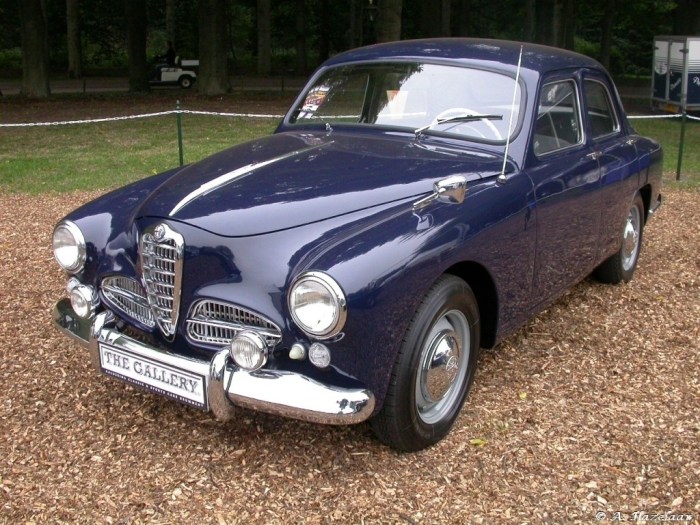
The Alfa Romeo 1900 wasn’t just a stylish road car; it was a born racer. Its performance on the track cemented its legacy as a high-performance machine, and its victories in major races helped establish Alfa Romeo as a force in international motorsport.
Notable Victories and Achievements
The 1900’s racing career was marked by several significant victories and achievements that solidified its reputation as a formidable competitor. Here are some of the highlights:
- 1950 Mille Miglia:Driven by Toulo de Graffenried and Giuseppe “Nino” Farina, the 1900 won the prestigious Mille Miglia, a grueling 1,000-mile race through Italy. This victory was a major statement, showcasing the 1900’s endurance and performance capabilities.
- 1951 Carrera Panamericana:The 1900 again demonstrated its endurance by achieving a 1-2 finish in the inaugural Carrera Panamericana, a 2,000-mile race through Mexico. This victory further cemented the car’s reputation for reliability and speed.
- 1952 Targa Florio:The 1900, piloted by Felice Bonetto and Gianni “Gigi” Villoresi, claimed victory in the demanding Targa Florio race in Sicily, further solidifying its status as a top-tier racing car.
Impact on Reputation and Legacy
The 1900’s racing success played a pivotal role in shaping Alfa Romeo’s reputation and legacy. Its victories in major races not only showcased the car’s performance capabilities but also highlighted Alfa Romeo’s engineering prowess and commitment to motorsport. This racing heritage contributed significantly to the brand’s image as a producer of high-performance, stylish automobiles.
Performance Against Other Racing Cars
The 1900 was a formidable competitor against other racing cars of its era. Its lightweight design, powerful engine, and excellent handling allowed it to excel on a variety of circuits. It faced stiff competition from other Italian manufacturers like Ferrari and Maserati, as well as international rivals like Jaguar and Mercedes-Benz.
The 1900’s victories in prestigious races like the Mille Miglia and Carrera Panamericana demonstrated its ability to compete with the best in the world.
Legacy and Influence
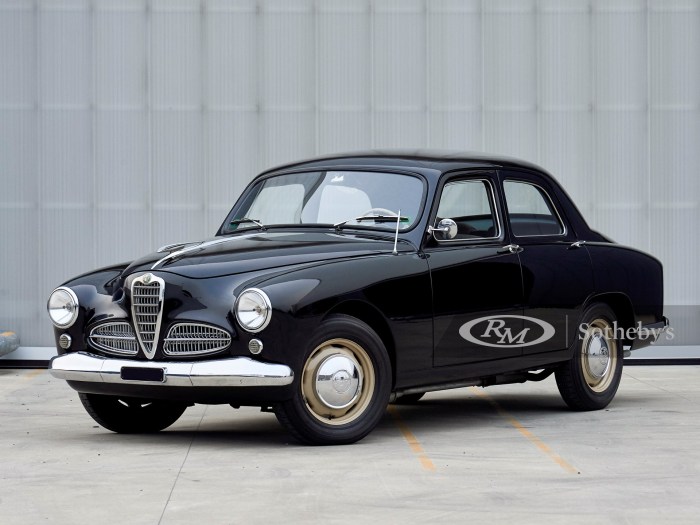
The Alfa Romeo 1900’s legacy extends beyond its technical innovations and racing successes. It profoundly shaped Alfa Romeo’s brand identity and influenced the design and engineering of future models, solidifying the marque’s reputation for performance and style.
The 1952 Alfa Romeo 1900 was a groundbreaking car, ushering in a new era of performance and style for the Italian marque. While it represented the pinnacle of Alfa Romeo’s engineering prowess at the time, the company continued to innovate, eventually giving birth to the iconic 1979 Alfa Romeo Spider , a car that captured the spirit of the 1900 but with a more accessible and sporty appeal.
Both models, in their own way, embodied the essence of Alfa Romeo: a blend of passion, performance, and Italian flair.
Impact on Alfa Romeo’s Brand Identity
The 1900 marked a significant shift in Alfa Romeo’s brand identity. Prior to its introduction, the company was primarily known for its racing prowess and exclusive, handcrafted vehicles. The 1900, with its mass-production approach and emphasis on practicality, broadened Alfa Romeo’s appeal to a wider audience.
This move, coupled with its elegant design and sporting performance, cemented Alfa Romeo’s image as a manufacturer of stylish and powerful cars for the discerning driver. The 1900’s success paved the way for future models like the Giulietta and Giulia, which continued to build upon the brand’s reputation for performance, style, and sophistication.
Influence on Other Vehicles
The 1900’s design and engineering innovations influenced a number of other vehicles, both within Alfa Romeo’s lineup and in the wider automotive industry. The car’s unitary construction, with its lightweight and rigid body, was adopted by other manufacturers, particularly in Europe.
Its aerodynamically refined bodywork, with its distinctive “Kamm tail” design, became a popular styling element for other sports cars and luxury sedans. Moreover, the 1900’s engine, with its advanced double overhead camshaft design, inspired the development of similar powerplants in other cars.
Enduring Appeal to Collectors and Enthusiasts, 1952 Alfa Romeo 1900
Today, the Alfa Romeo 1900 remains highly sought after by collectors and enthusiasts. Its timeless design, powerful performance, and historical significance make it a desirable classic car. The 1900’s rarity, particularly in its original condition, further contributes to its value.
Enthusiasts appreciate the car’s driving experience, which combines a blend of sportiness and refinement. The 1900’s legacy as a pivotal model in Alfa Romeo’s history, its contribution to the development of the modern sports car, and its enduring appeal to collectors ensure its continued place as a symbol of automotive excellence.
Cultural Significance
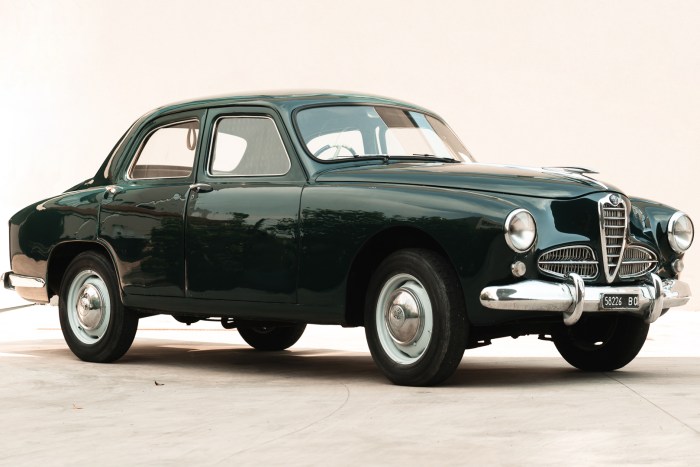
The Alfa Romeo 1900 transcends its status as a mere automobile; it embodies a specific era in automotive history and Italian design, leaving an indelible mark on popular culture. Its elegant lines, innovative engineering, and captivating performance have captivated audiences for decades, inspiring artists, writers, and filmmakers.
Depiction in Popular Culture
The 1900’s influence extends beyond the realm of automotive enthusiasts. It has graced the silver screen, appearing in films such as “The Italian Job” (1969), where a 1900 Sprint Zagato played a prominent role in the iconic heist. The car’s sleek silhouette and sporty demeanor have made it a favorite among filmmakers seeking to portray a sense of sophistication and style.
In literature, the 1900 has found its way into the pages of novels and short stories, often serving as a symbol of Italian craftsmanship and the allure of the open road. The car’s presence in these narratives adds a layer of depth and intrigue, reflecting the era’s fascination with speed and adventure.
Representation of an Era
The 1900 embodies the spirit of post-war Italy, a period of economic recovery and cultural resurgence. The car’s design, with its flowing lines and emphasis on aerodynamic efficiency, mirrored the nation’s aspirations for a brighter future. The 1900’s advanced engineering, featuring a lightweight aluminum body and a powerful engine, symbolized Italy’s growing industrial prowess and its determination to compete on a global stage.Furthermore, the 1900 represented a shift in automotive design, moving away from the bulky and utilitarian vehicles of the past towards a more streamlined and aesthetically pleasing approach.
This evolution, epitomized by the 1900, paved the way for the sleek and sophisticated sports cars that would become synonymous with Italian automotive excellence.
Final Review: 1952 Alfa Romeo 1900
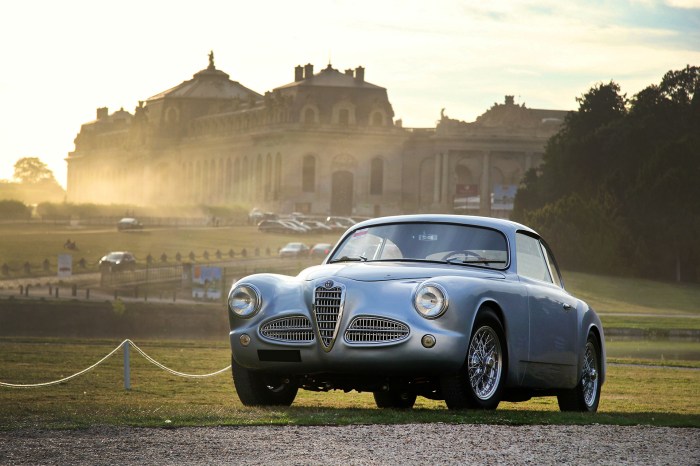
The 1952 Alfa Romeo 1900 stands as a timeless testament to the enduring allure of Italian automotive artistry. Its legacy transcends its initial production run, influencing generations of car designers and captivating collectors and enthusiasts alike. The 1900 continues to embody the spirit of innovation and elegance that has defined Alfa Romeo for over a century, leaving an indelible mark on the world of automobiles.